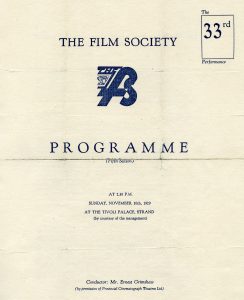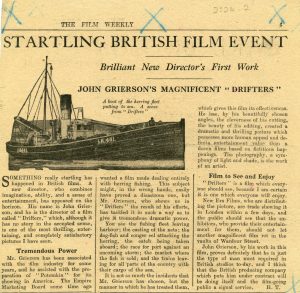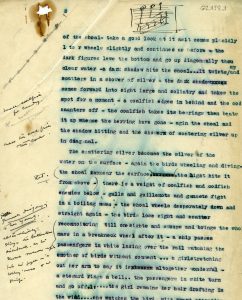On Sunday 10th November 1929 Battleship Potemkin, Sergei Eisenstein’s rousing work of cinematic drama and revolutionary propaganda, received its first public screening in Britain at an event organised by the Film Society at the Tivoli Palace, London. Made in 1925 the film tells the story of the mutiny of the crew of the Russian naval ship Potemkin in 1905, an event celebrated as an inspirational precursor to revolution in the new Soviet Russia of the 1920s. The screening was part of a programme which also included the premiere of John Grierson’s first film Drifters, a documentary about the heroic lives of North Sea fishermen. The Stirling-born director’s film had a huge impact and created a template for documentary films which many others followed, its success contributing to his reputation as ‘the father of documentary.’

Grierson had seen Potemkin on a visit to the US and its style heavily influenced his editing of Drifters. Writing in The Clarion on the eve of the film’s first London screening Grierson noted:
“I saw Potemkin first, rather more than three years ago. It was running in New York and making a noise among silents, which it will hardly do now. All of us who scribbled made a job of it. We wrote about tempo, about images, about mass character (crowds as personalities, streets, towns, peoples as corporate personalities) and on all these things which cinema could do that the stage could not do. It appears in company with my own Drifters, but I am not in competition. Eisenstein is a very great director and the master of us all.”
Grierson’s gift for promotion and marketing can be seen in the arrangements he made for the premiere of Drifters. Keen to promote his film to maximum effect Grierson insisted that Drifters should be shown before Eisenstein’s work and it stole the Russian film’s thunder. Grierson’s film impressed both audience and critics with a style and energy that was greatly indebted to Eisenstein, the Daily News reporting that it had “more real art that the much-belauded Russian picture.”

Forsyth Hardy in his biography of Grierson notes that Eisenstein was present at the London premieres. He recalls a conversation between the two filmmakers after the screening. “Why,” said Eisenstein to Grierson, “you must know all about Potemkin.” “Foot by foot and cut by cut”, replied Grierson.
Our John Grierson Archive holds a wealth of material relating to Drifters including a water-damaged copy of the script for the film where the ink has run across the page. It’s tempting to imagine that the pages got wet when Grierson was on board the trawlers in the North Sea shooting the dramatic scenes of fishermen at work which feature in the film.


Recent Comments